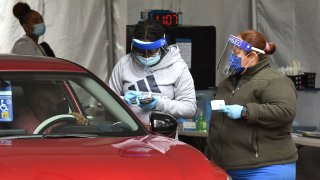
Lines of cars at testing sites - it's a sight that's become familiar around the state in the past couple of weeks with people hoping to find out their COVID-19 status to return to work or keep loved ones safe.
With the rise in COVID-19 infections, there's a couple of tips to keep in mind when we think about testing.
The good news is you have options when it comes to taking a test. There is a PCR test and an antigen test, commonly known as a rapid test, which can be taken at home.
"The PCR test, they're more sensitive, they tend to pick-up virus earlier in the course of the infection," said Dr. David Banach, an epidemiologist at UConn Health. "We've got the antigen test and those are really helpful in the setting of an active infection."
Get Connecticut local news, weather forecasts and entertainment stories to your inbox. Sign up for NBC Connecticut newsletters.
Banach also mentions there is a difference between the two.
"One of the challenges of the PCR test is that it does stay positive for a long period of time," said Banach.
So which test should you get if you're feeling better, aren't symptomatic and trying to get back to punching the clock?
Local
Here's what Banach recommends.
"An antigen test might be more helpful in kind of observing how someone is recovering from COVID infection," said Banach.
Some of the test questions emerged following the Center for Disease Control and Prevention's (CDC) announcement which states those who test positive for COVID19 are not required to test after 5 days of isolation.
The latest CDC recommendations if you test positive are:
- Stay home for five days.
- If you have no symptoms or your symptoms are resolving after five days, you can leave your house.
- Continue to wear a mask around others for five additional days.
- If you have a fever, continue to stay home until your fever resolves.
The biggest advice from Banach is to get tested to help cut down on COVID-19 transmission.
"It's all complements one another in order to sort of maximize our ability to identify virus and stop the spread," said Banach.



